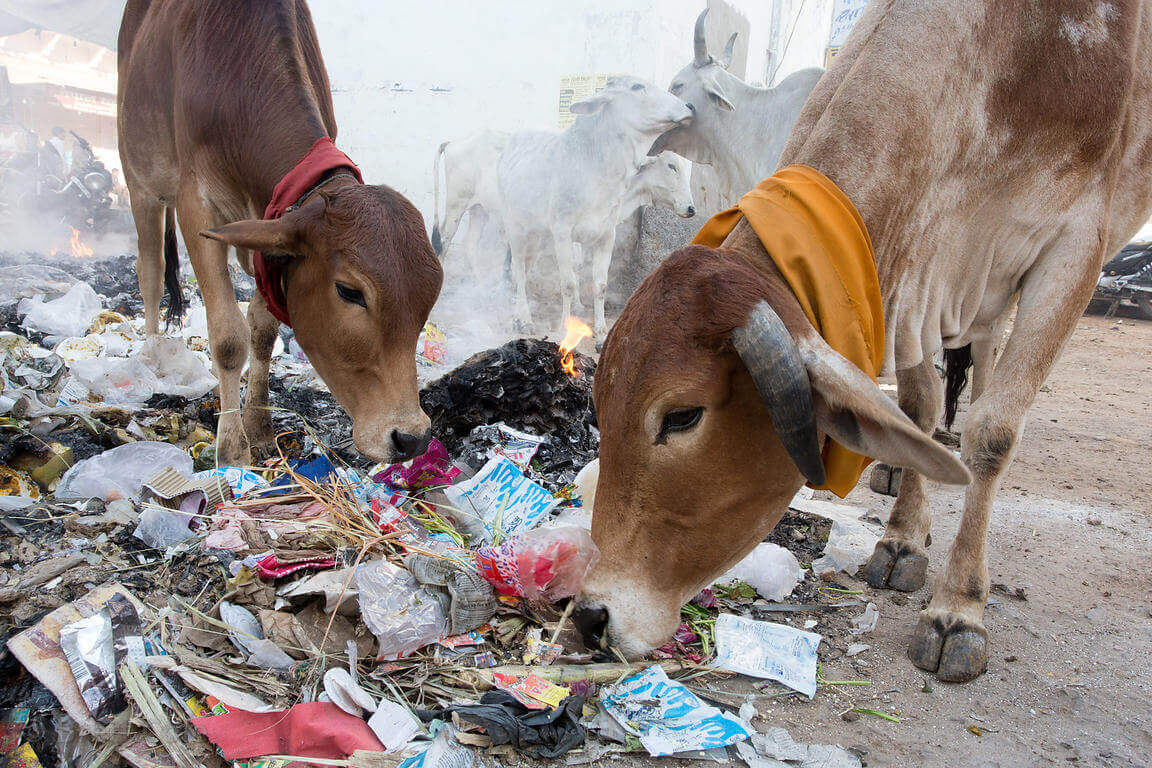A Human Rights Watch report reveals that, with support from law enforcement and Hindu nationalist politicians, radical cow protection groups have injured 280 people, and killed at least 44, in over 100 attacks between May 2015 and December 2018.
Cow vigilantism is propelled by communal politics which has taken on new and dangerous proportions under the Hindu-nationalist BJP, where even those who are associated with beef consumption run the risk of being subjected to mob violence. In fact, from the 44 killed, 36 were Muslim.
This attitude is underpinned by ancient Hindu scriptures which propagate the belief that cows are sacred, and should be protected and worshipped. Harming or killing a cow is thus considered vile, reprehensible and punishable.
And yet, gau rakshaks remain silent even as millions of cows graze across the vast urban landscape of India unencumbered, guzzling down hundreds of kilos of plastic, wading and crawling through our filth.
The open garbage system and ensuing plastic pollution threaten the health and wellbeing of cows. Hoping to find discarded food, cows rummage through plastic waste, and line their stomachs with indigestible inorganic materials.
This problem is exacerbated by the fact that very few households separate organic waste from plastic and glass. Vineet Arora, the treatment head at Society for Prevention of Cruelty to Animals (SPCA) in Noida, says, “Plastic utensils, covers and even razors mix with vegetable and fruit peels and leftover food.”
Arora remarks that post-mortems on cows have exposed almost one hundred kilos of plastic in their systems. The ingestion of plastics results in malnutrition, as it leaves insufficient room for food. Moreover, they begin producing toxic milk, contaminated with “paint, detergents, caustic soda, urea and shampoo”.
This not only endangers cows, but also humans, particularly before festivals, when milk-based sweets are consumed in exorbitant numbers. A test conducted in 2012-13 in Uttar Pradesh revealed that more than 25% of the 4500 milk samples tested contained detergent, starch and artificial whitener in order to cover up the toxic nature of the milk.
Cattle owners release their cows to traverse the concrete jungles of India owing to an inability to sufficiently feed them. As a cow’s health or capacity to produce milk declines, cattle owners abandon them in order to escape the financial burden of veterinary treatment.
This sorry state of affairs highlights an involuntary but complicit murder of cows that is difficult to distinguish from cow slaughter and meat consumption, and yet gau rakshaks deem that only the latter merits mob violence.
This begs the question: Are cows sacred in name only? If so, how can one truly champion their rights?
Difficult though it may seem, cattle safety and protection calls for the disestablishment of selective biases against the Muslim population, civic responsibility for proper recycling and waste disposal, subsidization of veterinary medical treatments, and restrictions on cattle ownership.
The support of politicians, law enforcement, and the legal system is required in order to ward off the dangers of communal violence and apply punishments for animal endangerment and abuse as per the rule of law, and not as per religiously motivated interpretations of it. Although Prime Minister Narendra Modi has condemned such mob violence, he deflects responsibility for the issue by saying that law and order is a state matter.
In addition, citizens must be self-accountable for their waste disposal techniques by practising waste segregation and proper disposal, instead of taking advantage of the open garbage system.
However, this shift in attitudes cannot be achieved overnight. It must be tackled through government initiatives to raise awareness of the dangers of pollution and the benefits of recycling and proper waste disposal.
Furthermore, in order to eradicate the open garbage system, it is vital for municipal governments to create multiple formal waste disposal sites with segregated bins to provide greater accessibility, especially for the less civically inclined. Campaigns such as the Swacch Bharat Abhiyan have thus far been unsuccessful in achieving meaningful change across these parameters outside of campaign slogans and rhetoric.
Simultaneously, it is vital for the government to subsidize the medical treatment and feeding of cattle so that cattle owners are able to provide proper care for their animals, resulting in a longer lifespan, less road congestion, and higher quality dairy products. The success of the 2013 National Livestock Policy, which stressed the need for “veterinary hospitals, dispensaries, aid centres, diagnostic laboratories and veterinary manpower”, has thus far been limited.
Nevertheless, in order to prevent a ‘handout system’, it is imperative to implement a minimum income level requirement for cattle ownership. Concurrently, there must be judiciously enforced financial penalties for circumventing such requirements and for livestock neglect and endangerment.
Therefore, only through the disestablishment of communal politics, promotion of civic responsibility, creation of more waste disposal and segregation sites, subsidization of veterinary treatments, and greater regulations on cattle ownership would it be possible to achieve the gau rakshaks’ purported aims of protecting cows.
However, in a deeply divided country–in which the BJP has only increased divisions–with a lack of self-accountability and government efficiency, aspiring for such an outcome seems idealistic at best and naïve at worst.
That leaves us with one question: Is cow vigilantism even about cows?
Are Cows Sacred In Name Only?
Cow vigilantism is on the rise, yet cows are no safer or healthier than they were before.
November 7, 2019

SOURCE: BRETT COLE
